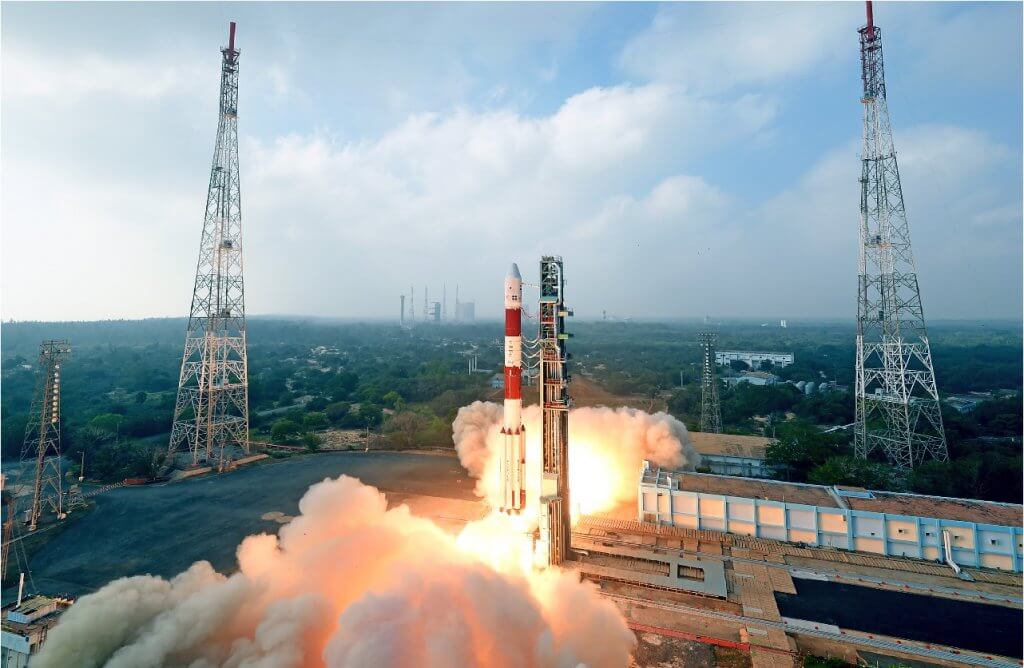Launching from the Satish Dhawan Space Centre, Sriharikota, India, an ISRO (Indian Space Research Organisation) PSLV-XL medium-lift launch vehicle has carried 31 spacecraft into Low Earth Orbit (LEO). The mission lifted-off at 0358 GMT and it’s primary payload was the 710 kg Cartosat-2F remote-sensing satellite – the seventh in the current series. This is the first launch for the PSLV since its August 2017failure, during which the single IRNSS-H satellite carried was lost due to a payload fairing malfunction.

The PSLV-XL lifts-off carrying 31 satellites to LEO. Courtesy of ISRO
Alongside Cartosat-2F on this latest flight there were two other Indian satellites; Microsat-TD, weighing 100 kg and built by ISRO as a technology demonstrator for the satellite platform, and INS-1C, the third Indian Nano-Satellite built by ISRO which showcases a miniature multi-spectral imager.
In addition to the three domestic Indian satellites, the launch also carried 28 spacecraft for international customers:
– 19 were carried for the USA: four Dove 3U-cubesats from Planet, four Lemur-2 3U-cubesats form Spire Inc; Demosat-2 a 3U-cubesat carrying a UHF transmitter for an unknown organisation; MICROMAS-2 a follow on to the MICROMAS mission by MIT Space Systems Laboratory; Tyvak-61C is a 3U-cubesat only known by its manufacturers’ designation for an unknown customer; four SpaceBee picosatellites – each 0.25U-cubesats – but launched as one unit to split into separate spacecraft in orbit; Fox-1D developed by AMSAT for amateur communication and research purposes; Corvus-BC 3R for Astro Digital to replace a similar satellite lost on a Soyuz launch in November 2017; Arkyd 6A for Planetary Resources to test technologies for their future asteroid mining satellites and Cicero 7 for GeoOptics Inc carrying a GNSS Radio Occultation payload.
– Five were carried for South Korea: Canyval-X by Yonsei University which actually consists of a 1U-cubesat and a 2U-cubesat joined together which will separate once in-orbit to test a virtual telescope system; CnuSail built by Chungnam University in a 3U-cubesat form to test a solar sail experiment; Kausat 5 a 3U-cubesat developed by the Korean Aviation University carrying an Infrared imager, Sigma or KhuSat 3 – a 3U-cubesat built by Kyung Hee University to measure the global magnetic field and radiation; and Step Cube Lab – a 1U-cubesat built by Chosun University to evaluate the potential of several on-board experiments,
– A single satellite was from the UK: the 100kg Carbonite 2 or CBNT 2 which is also known as VividX2, was built by SSTL for the new Earth-imaging company Earth-i. It will provide high-resolution, colour, video products.
– A Single satellite from France: Picsat is a 3U-cubesat built by the Observatoire de Paris to study exoplanetary transits.
– A single satellite for a Finnish company (IceEye X1 is a proof of concept satellite for IcEye to demonstrate their small-scale SAR imaging system.
– A single satellite for Canadian company FFS company Telesat. The LEO Vantage 1 was built by SSTL is one of two prototype Kaband HTS satellites ordered by Telesat to test their panned global LEO constellation. The SSL-built second satellite LEO Vantage 2 destroyed by its Fregat upper-stage during a Soyuz launch in November 2017.
Comment by Matt Wilson: The number of satellites launched on this mission will increase once in orbit due to the nature of some of the co-payloads.







